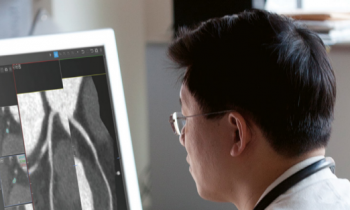
News • Opinion
Cloud computing vs. edge computing: rethinking healthcare infrastructure
Cloud computing isn’t exactly a new concept in the healthcare industry. Its benefits have become increasingly well-known across the sector and, without it, we wouldn’t have many health-related services that both healthcare professionals and patients now rely on.
Newer concepts like edge computing are regularly discussed alongside the cloud within the healthcare sector, often as if they are each exclusive approaches to infrastructure. However, using one does not eradicate the ability to utilise the other. Some people also believe that edge computing will eventually replace traditional cloud computing, however, this isn’t true. Both technologies have important and recognisable roles within a healthcare IT ecosystem.
Having said this, there are use cases where edge computing has advantages over traditional centralised cloud infrastructure, especially during this unprecedented increase in remote medicine, including overcoming latency issues, operational strain and security. So, what do these benefits look like?
Lightening the network load
The main differentiating factor between cloud computing and edge computing is how and where data processing takes place. With cloud, data is stored and processed in a central location (usually a data centre), whereas edge computing refers to data processing nearer the source.
We already live in a data-rich world with new technologies creating vast amounts of data that is generated close to the user or at the edge of the network. Today, sophisticated IoT-powered medical devices and equipment, wearables, and the masses of health data available for gathering new insights into disease prevention and treatment all make the healthcare industry a data-heavy sector. Remote medicine, which has seen an increase even before the COVID-19 pandemic, only also adds to this as more and more patients, healthcare professionals and researchers try to access data and services across a wider geography, away from central hospitals at more spread out locations within the community. The cloud itself has significant compute and storage capabilities, however, with such strain on network bandwidth, it requires a different type of infrastructure – this is where edge computing comes in.
Completely overhauling infrastructure to cope with this demand can be costly and time intensive for healthcare businesses. With edge computing, you don’t need to “rip and replace” infrastructure. Edge computing allows healthcare companies and trusts to resolve this challenge as processing data at the edge reduces dependence on centralised cloud servers. In conjunction with edge data centres, edge computing can tackle more localised data compute, processing, and analysis, increasing network efficiency and responsiveness, freeing up the cloud to be used for more general-purpose business needs.
Lowering latency

The nature of the cloud means that information is relayed back to the data centre, processed, and then sent back to the edge of the network where the device is. This can take time for data to travel back and forth and can cause lag or latency. In many use cases, where the need to process data is not time-sensitive, the cloud offers plenty processing power, storage, and large-scale data analysis. However, in some cases, especially in IoT data transmission and emergency medical scenarios, such latency can be life-threatening. For instance, hospital services need real-time patent information from ambulance teams. If there is a delay on this, they might not have the correct knowledge needed to save lives when the patient arrives.
Another example is a surgeon using assisted reality (AR) smart glasses during surgical procedures. AR allows surgeons to receive images and graphs over the top of their peripheral vision to assist with the operation or keep track of a patient’s vitals. You can easily imagine that if latency occurs, this can affect the surgeon’s ability to carry out critical tasks and potentially put a patient’s life at risk. Edge computing offers a solution to this by relocating data processing closer to the device at the edge of the network, eliminating latency and therefore reducing incidences of network lag related failure.
Securing healthcare data
As remote medicine rises, there is an increase in personal data being accessed remotely, which naturally raises security concerns. Healthcare data, in particular, is a lucrative target for cyber criminals and increased incidences of remote access give them greater opportunity to misuse sensitive information. With edge computing, data is filtered and processed locally, rather than sending it to a central data centre. Reducing the distance of data transfer and instances between devices and the cloud, means better security.
COVID-19 has undoubtedly altered an already evolving healthcare landscape. The cloud has allowed for data to be shared across organisations securely. However, edge computing provides an accessible, practical, and deployable solution that can help to ease bandwidth, increase network speeds, and tackle data security challenges. Choosing edge or cloud computing isn’t an either/or proposition, both technologies have different purposes and uses and will continue to have important roles for the foreseeable future. As telemedicine becomes the new norm for patients and healthcare workers alike, it is predictable that network infrastructure of the future will be a hybrid of the two.
Profile:
Nick Offin is the Head of Sales, Marketing and Operations, dynabook Northern Europe. His role includes managing sales teams across public, corporate and education sectors, and partners across UK&I and the Nordics.
08.06.2020











